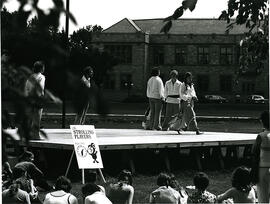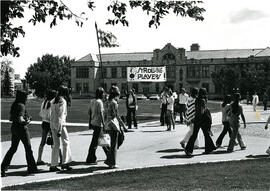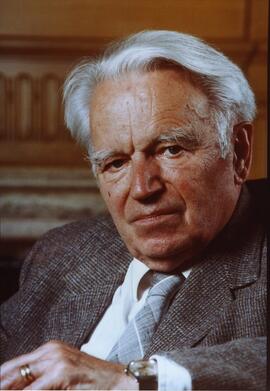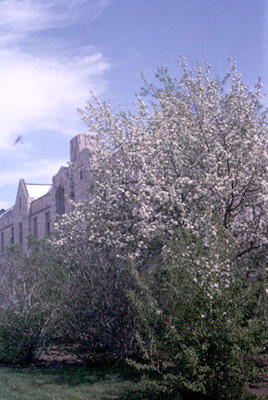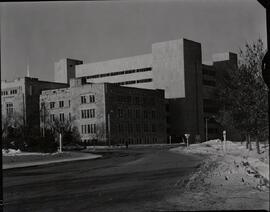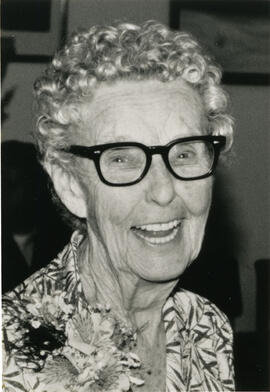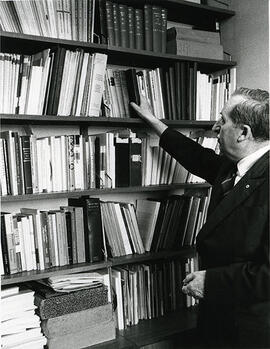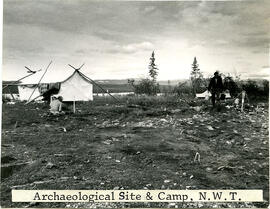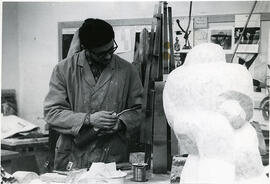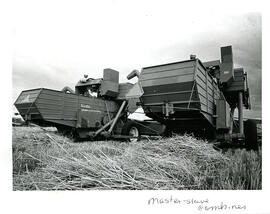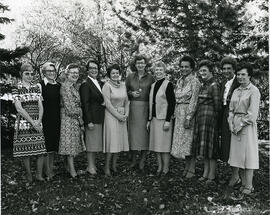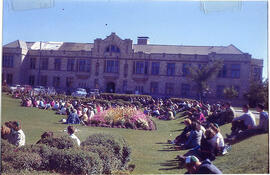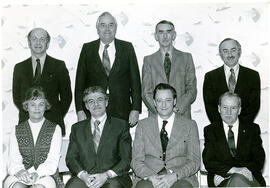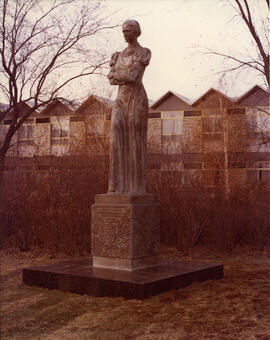Head and shoulders of Dr. Gerhard Herzberg, winner of the 1971 Nobel Prize for Chemistry.
Bio/Historical Note: Dr. Gerhard Heinrich Friedrich Otto Julius Herzberg was born in 1904 in Hamburg, Germany. After completing high school at the Gelehrtenschule des Johanneums, he continued his education at Darmstadt University of Technology. From 1928-1930 he carried out post-doctorate work at the University of Göttingen at the University of Bristol. In 1930 Dr. Herzberg was appointed Privatdozent (lecturer) and senior assistant in the Physics Department of the Darmstadt Institute of Technology. In August 1935 Dr. Herzberg was notified that he would be dismissed because his astrophysicist wife, Luise Herzberg, was Jewish, and he realized they would have to leave Nazi Germany. Dr. John Spinks, a visiting scientist from the University of Saskatchewan, arranged for the Herzbergs to come to Saskatoon. Gerhard Herzberg took up a guest professorship at the University of Saskatchewan, for which funds had been made available by the Carnegie Foundation. A few months later he was appointed research professor of Physics, a position he held until 1945. From 1945-1948 Dr. Herzberg was professor of spectroscopy at the Yerkes Observatory of the University of Chicago. He returned to Canada in 1948 and was made Principal Research Officer and shortly afterwards Director of the Division of Physics at the National Research Council. In 1955, after the Division had been divided into one in pure and one in applied physics, Dr. Herzberg remained Director of the Division of Pure Physics, a position he held until 1969 when he was appointed Distinguished Research Scientist in the recombined Division of Physics. Dr. Herzberg's main work concerned atomic and molecular spectroscopy. He was well known for using these techniques that determine the structures of diatomic and polyatomic molecules, including free radicals which are difficult to investigate in any other way, and for the chemical analysis of astronomical objects. Dr. Herzberg's most significant award was the 1971 Nobel Prize in Chemistry, which he was awarded "for his contributions to the knowledge of electronic structure and geometry of molecules, particularly free radicals.” During the presentation speech, it was noted that at the time of the award, Dr. Herzberg was "generally considered to be the world's foremost molecular spectroscopist."
Dr. Herzberg authored some classic works in the field of spectroscopy, including Atomic Spectra and Atomic Structure and the encyclopaedic four volume work: Molecular Spectra and Molecular Structure, which is often called the spectroscopist's bible. The three volumes of Molecular Spectra and Molecular Structure were re-issued by Krieger in 1989, including extensive new footnotes by Dr. Herzberg. Volume IV of the series, "Constants of diatomic molecules" is purely a reference work, a compendium of known spectroscopic constants (and therefore a bibliography of molecular spectroscopy) of diatomic molecules up until 1978. Dr. Herzberg was honoured with memberships or fellowships by a very large number of scientific societies, and received many awards and honourary degrees in different countries. Dr. Herzberg received an honourary Doctor of Laws degree from the University of Saskatchewan in 1953. The Herzberg Institute of Astrophysics (now called the NRC Herzberg Astronomy and Astrophysics Research Centre), in Victoria, British Columbia, was established in 1975. ‘Asteroid 3316 Herzberg’ was named after him in 1984. The Canadian Association of Physicists has an annual award named in his honour. The Herzberg Laboratories, housing the Physics and Mathematics/Statistics departments, is located at Carleton University. Gerhard Herzberg died in 1999 in Ottawa at age 94. The main building of John Abbott College in Montreal is named after him. A public park in the College Park neighbourhood of Saskatoon honours him. The NSERC Gerhard Herzberg Canada Gold Medal for Science and Engineering, Canada's highest research award, was named in his honour in 2000.
Bio/Historical Note: Dr. Luise Hedwig Herzberg (née Oettinger) was born 22 November 1906 in Nuremberg, Germany. She studied mechanical engineering at the Technische Hochschule in Munich prior to attending the University of Göttingen. She took one year of study at the University of Texas (Austin) prior to returning to Göttingen, where she met her future husband, Gerhard Herzberg. They married in Nuremburg on 30 December 1929. Luise joined Gerhard in his laboratory in Bristol, England, where she began her PhD research on the spectrum and structure of beryllium oxide (BeO). Dr. Herzberg continued her studies in Darmstadt, when the couple returned to Germany in November 1930. For various reasons, her PhD examination was conducted through the University of Frankfurt; Dr. Herzberg received her doctorate on 29 May 1933. She was quite possibly the last Jew to receive a PhD from Frankfurt before the war; the Nazis had come to power that January. The Herzbergs left Germany in 1935, and Gerhard accepted a position at the University of Saskatchewan. Despite the birth of their two children and the majority of her time taking care of their household, Dr. Herzberg was able to continue with some scientific work (although not as a faculty member). In 1945 Gerhard accepted a position with the University of Chicago, Dr. Herzberg was a “volunteer research associate.” In 1948, the family moved to Ottawa, where Gerhard had accepted a position with the National Research Council. Once again, she served as a “volunteer research associate.” By 1952 she had a summer position with the Dominion Observatory; in 1958 this became a full-time position. The final twelve years of Dr. Herzberg’s working career (beginning in 1959) were spent at the Radio Physics Laboratory at Shirley Bay. Luise Herzberg died in Ottawa on 3 June 1971, just prior to her planned retirement and five months before her husband, Gerhard, was awarded the Nobel Prize. Their son Paul noted that not only had “Gerhard ... won the Nobel Prize with Luise’s constant support,” two of Luise’s colleagues independently suggested that “given the opportunity, Luise might have exceeded Gerhard’s accomplishments and may also have won a Nobel Prize. Such is the high esteem in which Luise was held.”

